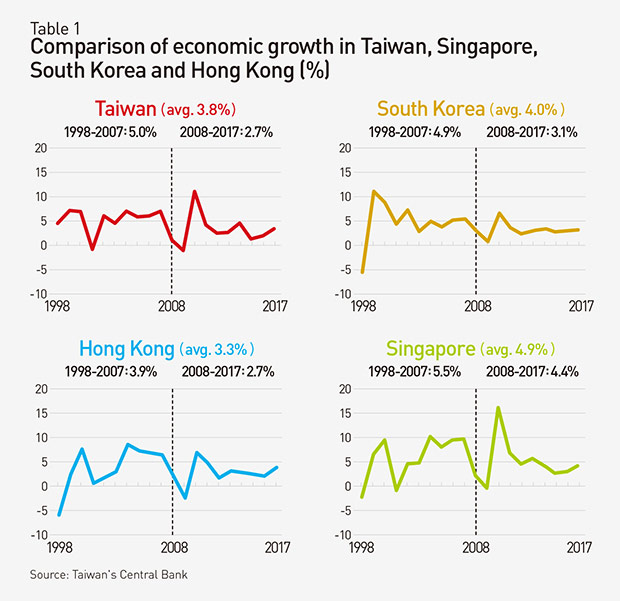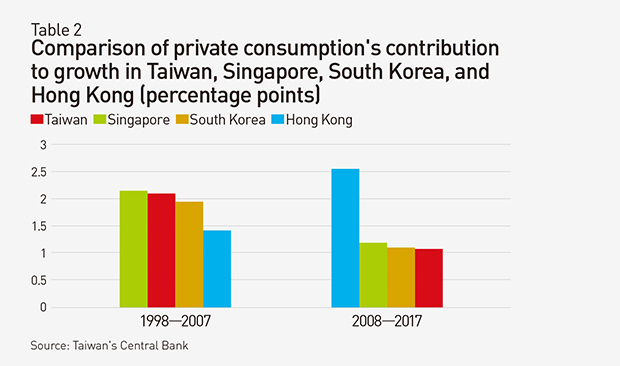Taiwan’s Economic Struggles Decoded
No Longer an Asian Tiger?

Source:Shutterstock
Taiwan has muddled through an extended period of relatively low growth, stagnant wages and outflows of talent to other countries. The central bank recently revealed why this is happening relative to some of Taiwan’s neighbors.
Views
No Longer an Asian Tiger?
By Pei-hua Luweb only
In late 2017, Academia Sinica sociologists published a study called “Unfinished Miracle: Taiwan’s Economy and Society in Transition” that detailed several factors behind Taiwan’s inability to sustain its economic miracle. (Read: Chronicling a 20-Year Decline)
On April 2, Taiwan’s central bank followed up with its own appraisal of why Taiwan has fallen behind among the four Asian Tigers – referring to Hong Kong, Singapore, South Korea and Taiwan – using several indicators to explain the country’s economic decline over the past 20 years.
In terms of economic growth, Taiwan grew at an annual rate of 2.7 percent from 2008 to 2017, the same as Hong Kong but trailing Singapore’s 4.4 percent and South Korea’s 3.1 percent. In the previous 10 years from 1998 to 2007, Taiwan grew at an average annual rate of 5 percent, compared to 3.9 percent in Hong Kong, indicating a bigger decline more recently than the other three economies. (Table 1) The country’s relatively low growth rate has contributed to Taiwan’s stagnant wages and persistent brain drain.

Two major weaknesses resulted in the 2.3 percentage point drop in economic growth from one decade to the next, according to the central bank. The first was a plunge in private consumption.
In a comparison of the four Asian Tigers’ economies during the two separate decades – from 1998 to 2007 and 2008 to 2017 – the central bank found that private consumption’s contribution to growth in the second 10 years was down 1.01 percentage points in Taiwan, the most of any of the four economies. Private consumption’s contribution in Singapore and South Korea was also down, but by less than a percentage point, and it actually rose in Hong Kong, serving as a pillar of growth in domestic demand. (Table 2)

Population Migration Taking Toll
The central bank attributed Taiwan’s weak domestic demand to several factors: slow wage growth, low birth rate and aging population, and the increasing number of people heading overseas to work. In 2016, there were 728,000 Taiwanese citizens working abroad, up 66,000 from 2009, according to estimates by the Directorate-General of Budget, Accounting and Statistics.
More white collar talent moving overseas has meant fewer relatively well-off people consuming at home, inevitably taking a toll on domestic consumption.
“Stagnant wages are the main factor [in weak private consumption],” the central bank report asserted.
Presiding over his first central bank board meeting in March, new central bank governor Yang Chin-long said there was clearly a disconnect between Taiwan’s labor productivity and wage growth, with labor productivity growing more than 110 percent since 1994 but real wage growth rising less than 30 percent during that time.
Low wages have also captured the attention of legislators. Kuomintang lawmaker Tseng Ming-chung lamented that 34 percent of salary earners make less than NT$30,000 a month and another 32 percent make between NT$30,000 and NT$40,000. In other words, 5.93 million people representing more than 60 percent of Taiwan’s workforce earn less than NT$40,000 a month. (Table 3)

The central bank has offered some solutions to boosting wages, including calling on companies to raise wages, promoting a “minimum wage law,” increasing the rate of unionization, and having the government take a cautious approach to increasing statutory benefits to avoid limiting companies' ability to raise wages.
Those benefits, considered as “non-salary compensation,” include companies’ steadily rising contributions to social insurance programs, such as for health insurance, labor pensions and labor insurance.
Companies Saving, not Investing
The second major weakness identified in the central bank report has been a decline in fixed investment’s contribution to growth, embodied by banks’ high excess savings rate.
At the end of last year, former central bank governor Perng Fai-nan criticized the inaction of companies, saying that since 2009 they have saved far more than they have borrowed to invest, bloating Taiwan’s excess savings – defined as gross savings in excess of gross investment.
From 1998 to 2007, companies had negative excess savings, central bank statistics show, indicating that companies were eager to borrow and invest. But from after the global financial crisis to 2016, companies built up more than NT$500 billion in excess savings, leaving banks flush with cash and worried about their inability to lend it out.
In looking at other countries, though Singapore’s excess savings rate appears high, it has remained steady and generally reflects government savings from high budget surpluses. The excess savings rate is falling in Hong Kong but rising in South Korea, though at a much slower pace than in Taiwan, signaling Taiwan’s lack of investment momentum. (Table 4)

Taiwanese companies’ conservative approach to investing has plunged them into a vicious cycle and eroded their international visibility relative to Chinese enterprises. The country must find a way to embolden companies to invest and innovate while also coming to grips with its social welfare policies, labor issues and population policies if it hopes to once again experience a sustained period of higher growth.
Translated from the Chinese article by Luke Sabatier
Additional Reading
♦ Chronicling a 20-Year Decline
♦ Taiwan Mired in 1980s Mentality
♦ Taiwan’s Growing Talent Drain:‘Farewell, Taiwan’







